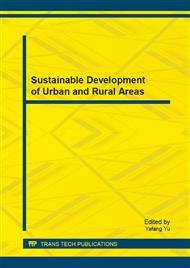p.825
p.829
p.833
p.837
p.841
p.845
p.851
p.855
p.859
Enhanced Phytoextraction of EDTA and EDDS in Polluted Soil
Abstract:
In order to minimum high environmental persistence while enhancing the effects of phytoextract heavy metals in plant, though applied different ratio of non-biological chelating agent EDTA and biological chelating agent EDDS application phytoremediation into the Rape (Brassica campestris L), monocots corn (Zea mays L). This experiment was conducted with a simulation in Pb, Cu, Cd complex artificially contaminated soil. The results show that appling chelator EDTA-EDDS application on the corn and the rape were play important promoting role in the metal of soil, and were more than the effects of the accumulation of the single EDTA or single EDDS. The concentrations of mobile metals Pb, Cu in soil were the highest of 386.5 mg·kg-1, 1369 mg·kg-1, adding treatment 2 (EDTA / EDDS = 2:1), respectively the control group. The concentrations of mobile metals Cd in soil were the highest of 89.6 mg·kg-1, adding treatment 3 (EDTA / EDDS = 1:1), respectively the control group.
Info:
Periodical:
Pages:
841-844
Citation:
Online since:
January 2014
Authors:
Price:
Сopyright:
© 2014 Trans Tech Publications Ltd. All Rights Reserved
Share:
Citation:


